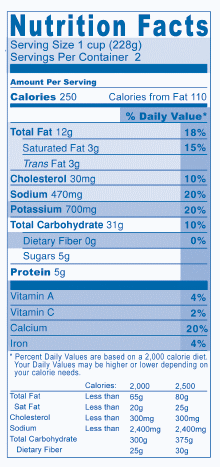|
Nutrition Label Reading 101
If trying to decipher a nutrition label seems like learning a foreign language to you... ...keep reading. I invite you to take a hypothetical trip to the grocery store with me, your personal nutrition guide. What's the first thing I look at on a nutrition label? The ingredient list, hands down. That's right, before I even consider the number of calories, grams of protein or fat, or how a particular food is going to fit into my weight loss or weight maintenance regimen, I want to know what the heck I'm eating! I understand that food is MORE than numbers... ...it's information. I trust that if I choose the right kinds of foods, I will be in a good mood, boost my metabolism, manage my hunger, be able to keep going like the Energizer bunny, and enjoy lifelong health. When relying on packaged/processed foods, picking the "right foods" is a bit trickier than when relying on whole foods in their natural forms. So, keep these points in mind when analyzing nutrition labels... 1. Look for those with a minimal number of ingredients in the list. (I'm also happy when I recognize all the words in the list!) For example, the ingredient list of one of my favorite energy bars, LaraBar says: "dates, pistachios, cashews." I think we can all agree we've heard those words before and know what they are. 2. Look to make sure your nutrition labels DON'T report:
I've got an idea... ...Welcome back. That was a lot of work, wasn't it?! I bet you burned a lot of calories :-) After deciding if a food is worthy of ingesting, other factors I would take into consideration on the nutrition label are:
Ideally, a serving of food is low in fat, cholesterol, sodium, and sugar and high in fiber.
Serving Size Serving sizes are standardized to make it easier to compare similar foods; they are provided in familiar units, such as cups or pieces, followed by the metric amount, e.g., the number of grams. Pay attention to the serving size and especially to how many servings there are in the food package. Then ask yourself, "How many servings am I consuming"? (e.g., 1/2 serving, 1 serving, or more). In the sample label, one serving equals one cup. If you ate the whole package, you would have eaten two cups. Calories In this example, 1 serving has 250 calories, so if you eat two cups, you've just downed 500 calories! Eating too many calories per day is linked to overweight and obesity. (Determine your daily calorie budget.) Here is a general guide to calories:
Total Fat, Cholesterol and Sodium These are generally things we eat too much of. Doing so increases the risk of heart disease, some cancers and high blood pressure. Under Total Fat on the nutrition label, notice a breakdown of different types of fat called Saturated Fat and Trans Fat. Saturated Fat comes mainly from animal foods (so the number of grams will be high on cheese, butter, and ice cream labels) and is negatively associated with heart health. Trans Fats are formed when oils are partially hydrogenated (that's why you scan the ingredient list for partially hydrogenated oil and avoid foods that have them) and are also negatively associated with heart health. (I recommend avoiding all trans fat.) Cholesterol is found in all foods of animal origin (butter, ice cream, chicken, beef) and is negatively associated with heart health. Sodium can make you retain fluid, which shows up as extra weight on the scale. Excess is not good for blood pressure either! Other words for "salt" in the ingredient list are:
When a food is called "sodium free," it means it must contain less than 5 milligrams of sodium per serving. When a food is called "very low sodium," it means it must contain 35 milligrams or less of sodium per serving. When a food is called "low sodium," it means it must contain 140 milligrams or less of sodium per serving. So, when you search a nutrition label for the number of grams of saturated fat and trans fat, along with the milligrams of cholesterol and sodium, the goal is to keep the numbers as low as possible!
Fiber You can use nutrition labels not only to help limit those nutrients you want to cut back on but also to increase those nutrients it's best to consume in greater amounts. Fiber is one of these. Most Americans don't get enough dietary fiber. If you are trying to lose weight, fiber will help you feel full! Also, a diet that contains fiber (especially soluble fiber) and is low in saturated fat and cholesterol may reduce the risk of heart disease. So look for high numbers in the fiber column! Sugar If you start by reading the ingredient list, you'll know if the food has added sugar. Other words for sugar are:
Every 4 grams of sugar is representative of 1 tsp. of sugar. Our sample food has just over 1 tsp. of sugar (5 grams). If you look at the nutrition label on milk or plain yogurt you will see a fair number of grams of sugar. However, if you look at the ingredient list, you won't see any added sugar. So, the number of sugar grams is reflective of the naturally occurring milk sugar, not added sugar. % Daily Value Notice the farthest column to the right says % Daily Value (DV). This suggests how the nutrients fit into a 2,000 calorie daily diet. Which is useful... ...if you follow a 2000 calorie diet. But, I don't, most of my clients don't, and you may not either. (How many calories do you need in a day?) However, you can still use the %DV as a frame of reference. It helps you determine if a serving of food is high or low in a nutrient. As a general rule:
So in the label example above, the food is low fiber (0%) and high sodium (20%)...NOT a good choice! Nutrition labels have a lot of good information And you know what? A lot of food companies fought pretty hard to try to keep you from having all that good information. Informed consumers didn't win the nutrition label battle until 1993. Now use what you've learned to eat better! The Healthy Eating page. Your Personal Nutrition Guide home. |








